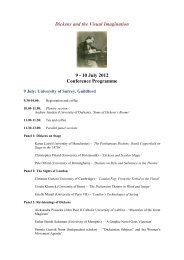The targeted killing of terrorists on foreign soil - Institute of Advanced ...
The targeted killing of terrorists on foreign soil - Institute of Advanced ...
The targeted killing of terrorists on foreign soil - Institute of Advanced ...
Create successful ePaper yourself
Turn your PDF publications into a flip-book with our unique Google optimized e-Paper software.
Tobias Ruettersh<str<strong>on</strong>g>of</str<strong>on</strong>g>f<br />
Panel 4 (a)<br />
cross-border situati<strong>on</strong> definitely have to come under it (see Jinks 2003, 43). Hence, the<br />
noti<strong>on</strong> <str<strong>on</strong>g>of</str<strong>on</strong>g> n<strong>on</strong>-internati<strong>on</strong>al armed c<strong>on</strong>flict is not c<strong>on</strong>fined to the territory <str<strong>on</strong>g>of</str<strong>on</strong>g> a state. Instead,<br />
Comm<strong>on</strong> Article 3 GC covers all c<strong>on</strong>flicts that are not internati<strong>on</strong>al. Thus, IHL is principally<br />
applicable to the <str<strong>on</strong>g>targeted</str<strong>on</strong>g> <str<strong>on</strong>g>killing</str<strong>on</strong>g> <str<strong>on</strong>g>of</str<strong>on</strong>g> <str<strong>on</strong>g>terrorists</str<strong>on</strong>g> (see Schmitz-Elvenich 2007, 188).<br />
However, the general applicability <str<strong>on</strong>g>of</str<strong>on</strong>g> IHL to transnati<strong>on</strong>al counter-terrorism does not reveal<br />
anything about requirements needed for a n<strong>on</strong>-internati<strong>on</strong>al armed c<strong>on</strong>flict. Other than in<br />
internati<strong>on</strong>al armed c<strong>on</strong>flict, those requirements are not clearly normed, which is partly<br />
based <strong>on</strong> the fact that n<strong>on</strong>-internati<strong>on</strong>al armed c<strong>on</strong>flicts <str<strong>on</strong>g>of</str<strong>on</strong>g>ten interfere with domestic laws<br />
and states certainly have no interest that every riot or uprising invokes Comm<strong>on</strong> Article 3<br />
GC (ibid., 190 f.). Still, some general requirements can be deduced from the ICJ’s general<br />
definiti<strong>on</strong> <str<strong>on</strong>g>of</str<strong>on</strong>g> armed c<strong>on</strong>flict in the Tadic case (see above, 19).<br />
Firstly, it says something about the durati<strong>on</strong> a c<strong>on</strong>flict must have to qualify as n<strong>on</strong>internati<strong>on</strong>al<br />
armed c<strong>on</strong>flict. By menti<strong>on</strong>ing “protracted, armed violence”, the court refers to<br />
a similar phrase in Article 1 (1) AP II which requires “sustained and c<strong>on</strong>certed military<br />
operati<strong>on</strong>s” (ICRC 1977b). In c<strong>on</strong>trast, Article 1 (2) AP II sees “internal disturbances and<br />
tensi<strong>on</strong>s, such as riots, isolated and sporadic acts <str<strong>on</strong>g>of</str<strong>on</strong>g> violence” (ibid.) as not sufficient<br />
enough. Similar provisi<strong>on</strong>s can be found in Article 8 (2)(d) and (f) <str<strong>on</strong>g>of</str<strong>on</strong>g> the Rome Statute <str<strong>on</strong>g>of</str<strong>on</strong>g> the<br />
ICC (see ICC 1998). C<strong>on</strong>trary, c<strong>on</strong>trary to an internati<strong>on</strong>al armed c<strong>on</strong>flict, n<strong>on</strong>-internati<strong>on</strong>al<br />
armed c<strong>on</strong>flict requires a l<strong>on</strong>g-term dispute between a state and a n<strong>on</strong>-state actor. Within the<br />
scope <str<strong>on</strong>g>of</str<strong>on</strong>g> the internati<strong>on</strong>al fight against terrorism, the protracted nature can certainly be<br />
affirmed.<br />
Sec<strong>on</strong>dly, the term “protracted, armed violence” also implies a certain intensity a c<strong>on</strong>flict<br />
must have to qualify as n<strong>on</strong>-internati<strong>on</strong>al armed c<strong>on</strong>flict. As <strong>on</strong>e might argue, single terrorist<br />
attacks (or resp<strong>on</strong>ses to it) do not show enough intensity to be classed as n<strong>on</strong>-internati<strong>on</strong>al<br />
armed c<strong>on</strong>flict (see Vöneky 2004, 943). But, a holistic view is necessary in this case.<br />
Similarly to the noti<strong>on</strong> or “armed attack” under the ius ad bellum, a subsumpti<strong>on</strong> <str<strong>on</strong>g>of</str<strong>on</strong>g> several<br />
terrorist attacks under the accumulati<strong>on</strong> <str<strong>on</strong>g>of</str<strong>on</strong>g> events doctrine (see above, 17) is possible if they<br />
take place in a c<strong>on</strong>nective frame (see Schmitz-Elvenich 2007, 194 f.).<br />
Thirdly, for the presence <str<strong>on</strong>g>of</str<strong>on</strong>g> a n<strong>on</strong>-internati<strong>on</strong>al armed c<strong>on</strong>flict, a certain degree <str<strong>on</strong>g>of</str<strong>on</strong>g><br />
organisati<strong>on</strong> is required <strong>on</strong> the side <str<strong>on</strong>g>of</str<strong>on</strong>g> the n<strong>on</strong>-state actor, as the phrase “organised armed<br />
groups” (see ICTY definiti<strong>on</strong> above, 19) implies. <str<strong>on</strong>g>The</str<strong>on</strong>g> fact is, terrorist organisati<strong>on</strong> <str<strong>on</strong>g>of</str<strong>on</strong>g>ten<br />
have an incredible command structure which <str<strong>on</strong>g>of</str<strong>on</strong>g>ten resembles that <str<strong>on</strong>g>of</str<strong>on</strong>g> armed forces. This<br />
- 19 -
















